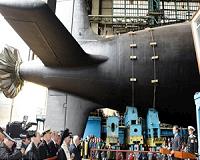| . |  |
. |
Washington DC (SPX) Jul 16, 2010 Speakers made from carbon nanotube sheets that are a fraction of the width of a human hair can both generate sound and cancel out noise - properties ideal for submarine sonar to probe the ocean depths and make subs invisible to enemies. That's the topic of a report on these "nanotube speakers," which appears in ACS' Nano Letters, a monthly journal. Ali Aliev and colleagues explain that thin films of nanotubes can generate sound waves via a thermoacoustic effect. Every time that an electrical pulse passes through the microscopic layer of carbon tubes, the air around them heats up and creates a sound wave. Chinese scientists first discovered that effect in 2008, and applied it in building flexible speakers. In a remarkable demonstration the Chinese nanoscientists stuck a sheet of nanotubes onto the side of a flag, and attached it to an mp3 player. They used the nanotube-coated flag to play a song while it flapped in the breeze. But they did not test its ability to operate under water. Aliev's group took that step, showing that nanotube sheets produce the kind of low-frequency sound waves that enable sonar to determine the location, depth, and speed of underwater objects. They also verified that the speakers can be tuned to specific frequencies to cancel out noise, such as the sound of a submarine moving through the depths.
Share This Article With Planet Earth
Related Links American Chemical Society Naval Warfare in the 21st Century
 New Russian Nuclear Submarine Will Not Enter Serial Production
New Russian Nuclear Submarine Will Not Enter Serial ProductionMoscow, Russia (RIA Novosti) Jun 23, 2010 A fourth-generation Russian nuclear-powered multipurpose attack submarine that was floated out on Tuesday is too expensive for serial production, a business daily said on Wednesday. On Tuesday, Russian President Dmitry Medvedev arrived in the northern port of Severodvinsk to attend the official float-out ceremony. The construction of the Severodvinsk, the first Project 885 Yasen (Gra ... read more |
|
| The content herein, unless otherwise known to be public domain, are Copyright 1995-2010 - SpaceDaily. AFP and UPI Wire Stories are copyright Agence France-Presse and United Press International. ESA Portal Reports are copyright European Space Agency. All NASA sourced material is public domain. Additional copyrights may apply in whole or part to other bona fide parties. Advertising does not imply endorsement,agreement or approval of any opinions, statements or information provided by SpaceDaily on any Web page published or hosted by SpaceDaily. Privacy Statement |